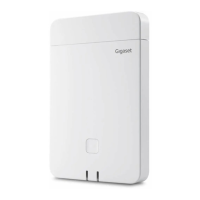
Do you have a question about the Gigaset N670 IP PRO and is the answer not in the manual?
| GAP compatible | Yes |
|---|---|
| Channels quantity | 120 channels |
| Compatible products | S650H, R650H, SL750H, Maxwell C |
| Security algorithms | HTTPS, SIPS, SRTP, SSL/TLS |
| Number of handsets supported (max) | 20 |
| Number of parallel conferences | 8 |
| Antenna type | Omnidirectional |
| Ethernet LAN (RJ-45) ports | 1 |
| Product color | White |
| Housing material | Plastic |
| Harmonized System (HS) code | 85177900 |
| Weight | 220 g |
|---|---|
| Package depth | 65 mm |
| Package width | 163 mm |
| Package height | 223 mm |
| Package weight | 380 g |
| Dimensions (WxDxH) | 110 x 42 x 180 mm |
Details the physical components of the N670 IP PRO base station.
Explains how to expand range using multiple N670 IP PRO devices.
Describes enabling multiple SIP accounts per handset and internal calls.
Lists the items included in the N670 IP PRO package.
Provides guidance on physically installing the N670 IP PRO device.
Explains how to connect the N670 IP PRO to the local network via Ethernet.
Explains how to set the role of the N670 IP PRO (e.g., Base station, Integrator).
Explains the meaning of the LED indicators on the base station.
Describes how to reset the base station using the device button.
Details the login procedure and user roles for the web configurator.
Explains how to save configuration changes.
Covers filtering, sorting, and displaying/hiding columns in web configurator lists.
Configures IP addressing, subnetting, and VLAN tagging for network integration.
Explains the subnet mask's role in defining the local network.
Configures DNS servers for name resolution.
Allows assigning base stations to DECT managers and viewing their status.
Explains the importance and methods of synchronising base stations.
Guides on setting up profiles for VoIP providers or PBX systems.
Configures domain, proxy server, and registration refresh time.
Selects and configures voice codecs for VoIP calls.
Allows setting up and managing SIP accounts for VoIP calls.
Details the process of entering SIP account data for registration.
Assigns registered SIP accounts to specific handsets for calls.
Allows registering, editing, and managing mobile devices (handsets).
Manages the registration and de-registration of handsets with the DECT network.
Configures handset-specific settings like VoIP accounts and provider data.
Configures basic SIP and secure SIP ports, and various VoIP timers.
Configures QoS values for SIP and RTP packets to prioritize voice data.
Enables or disables the wideband codec G.722 for enhanced audio quality.
Sets up and manages LDAP directories for corporate contact access.
Configures online directories in XML format, including public and corporate types.
Provides a central phone book for all users, sourced from server or PC.
Configures custom menu entries for Info Centre using XHTML pages.
Sets up servers for AML features including alarming, messaging, and location.
Defines access rights and manages passwords for web configurator users.
Manages license keys for features like multicell integration and AML services.
Manages firmware updates for the N670 IP PRO base station.
Allows saving and restoring the system configuration for backup and recovery.
Provides an overview of the system's operational status and device information.
Displays diagnostic counters for events affecting base stations.
Configures SysLog servers for system reports and SNMP for network monitoring.
Generates diagnostic dumps (core, RAM, sysdump) for detailed troubleshooting.
Explains how to make calls using any registered handset.
Explains how to answer incoming calls on the handset.
Explains how to manage three-way conversations, including consultation calls and call swapping.
Details how to enter access data for the LDAP server in the web configurator.
Configures criteria for searching objects within the LDAP database.
Explains how LDAP directories are accessed and displayed on the handsets.
Provides essential safety guidelines for using the device.
Provides steps to follow if the device comes into contact with liquid.
Lists key specifications like power consumption, protocols, and DECT standards.
Information about the power adapter as an optional accessory.
Information on upgrading the system with additional handsets.